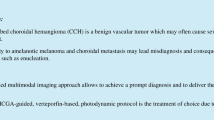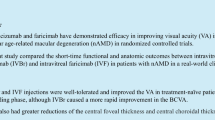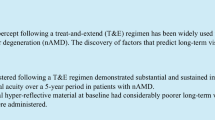Abstract
Purpose
This study aimed to investigate growth of polypoidal choroidal vasculopathy (PCV) without exudative findings assessed in en face optical coherence tomography (OCT) images and its clinical implications.
Methods
Fifty patients who were diagnosed with PCV and had no disease activity after treatment with intravitreal anti-vascular endothelial growth factor (anti-VEGF) were included. Patients were followed up for at least 12 months. Measurement of best-corrected visual acuity and volume scan using swept-source OCT was performed at each visit. The neovascular area of PCV was assessed using en face OCT. Growth group comprised patients who showed increase in neovascular area in the en face images without exudative findings. The main outcome measure was relationship between growth of PCV and recurrence.
Results
Among 50 eyes of 50 patients with average age of 68.5 ± 8.6 years, 25 (50%) eyes were included in the growth group. Exudative recurrence was noted more frequently in the growth group (18 eyes, 72%) than in the non-growth group (6 eyes, 24%, P = .002, odds ratio = 8.143). More injections were performed in the growth group (4.7 ± 2.1 vs. 1.9 ± 2.4, P = .002), but there was no difference in visual acuity at 1 year. After an exudative recurrence following the lesion growth, more frequent injections were required than before the recurrence to achieve no disease activity (P = .002).
Conclusion
PCV lesion growth without fluid preceded exudative recurrence and worsening of response to anti-VEGF treatment.





Similar content being viewed by others
References
Yannuzzi LA, Sorenson J, Spaide RF, Lipson B (1990) Idiopathic polypoidal choroidal vasculopathy (IPCV). Retina 10:1–8
Ciardella AP, Donsoff IM, Huang SJ, Costa DL, Yannuzzi LA (2004) Polypoidal choroidal vasculopathy. Surv Ophthalmol 49:25–37
Lee JW, Kim IT (2007) Epidemiologic and clinical characteristics of polypoidal choroidal vasculopathy In korean patients. J Korean Ophthalmol Soc 48:63–74
Koh A, Lai TYY, Takahashi K, Wong TY, Chen LJ, Ruamviboonsuk P, Tan CS, Feller C, Margaron P, Lim TH, Lee WK, EVEREST II study group (2017) Efficacy and safety of ranibizumab with or without verteporfin photodynamic therapy for polypoidal choroidal vasculopathy: A randomized clinical trial. JAMA Ophthalmol 135:1206–1213
Lee WK, Iida T, Ogura Y, Chen SJ, Wong TY, Mitchell P, Cheung GCM, Zhang Z, Leal S, Ishibashi T, Investigators PLANET (2018) Efficacy and safety of intravitreal aflibercept for polypoidal choroidal vasculopathy in the PLANET study: A randomized clinical trial. JAMA Ophthalmol 136:786–793
Hikichi T (2018) Six-year outcomes of antivascular endothelial growth factor monotherapy for polypoidal chroidal vasculopathy. Br J Ophthalmol 102:97–101
Chang YS, Kim JH, Kim KM, Kim JW, Lee TG, Kim CG, Cho SW (2016) Long-term outcomes of anti-vascular endothelial growth factor therapy for polypoidal choroidal vasculopathy. J Ocul Pharmacol Ther 32:219–224
Saito M, Iida T, Kano M, Itagaki K (2014) Five-year results of photodynamic therapy with and without supplementary antivascular endothelial growth factor treatment for polypoidal choroidal vasculopathy. Graefes Arch Clin Exp Ophthalmol 252:227–235
Palejwala NV, Jia Y, Gao SS, Liu L, Flaxel CJ, Hwang TS, Lauer AK, Wilson DJ, Huang D, Bailey ST (2015) Detection of non-exudative choroidal neovascularization in age-related macular degeneration with optical coherence tomography angiography. Retina 35:2204–2211
Nehemy MB, Brocchi DN, Veloso CE (2015) Optical coherence tomography angiography imaging of quiescent choroidal neovascularization in age-related macular degeneration. Ophthalmic Surg Lasers Imaging Retina 46:1056–1057
Querques G, Souied EH (2015) Vascularized drusen: slowly progressive type 1 neovascularization mimicking drusenoid retinal pigment epithelium elevation. Retina 35:2433–2439
Roisman L, Zhang Q, Wang RK, Gregori G, Zhang A, Chen CL, Durbin MK, An L, Stetson PF, Robbins G, Miller A, Zheng F, Rosenfeld PJ (2016) Optical coherence tomography angiography of asymptomatic neovascularization in intermediate age-related macular degeneration. Ophthalmology 123:1309–1319
Carnevali A, Cicinelli MV, Capuano V, Corvi F, Mazzaferro A, Querques L, Scorcia V, Souied EH, Bandello F, Querques G (2016) Optical coherence tomography angiography: a useful tool for diagnosis of treatment-naïve quiescent choroidal neovascularization. Am J Ophthalmol 169:189–198
Lee JE, Shin JP, Kim HW, Chang W, Kim YC, Lee SJ, Chung IY, Lee JE, VAULT study group (2017) Efficacy of fixed-dosing aflibercept for treating polypoidal choroidal vasculopathy: 1-year results of the VAULT study. Graefes Arch Clin Exp Ophthalmol 255:493–502
Tomiyasu T, Nozaki M, Yoshida M, Ogura Y (2016) Characteristics of polypoidal choroidal vasculopathy evaluated by optical coherence tomography angiography. Invest Ophthalmol Vis Sci 57:324–330
Wang M, Zhou Y, Gao SS, Liu W, Huang Y, Huang D, Jia Y (2016) Evaluating polypoidal choroidal vasculopathy with optical coherence tomography angiography. Invest Ophthalmol Vis Sci 57:526–532
Alasil T, Ferrara D, Adhi M, Brewer E, Kraus MF, Baumal CR, Hornegger J, Fujimoto JG, Witkin AJ, Reichel E, Duker JS, Waheed NK (2015) En face imaging of the choroid in polypoidal choroidal vasculoathy using swept-source optical coherence tomography. Am J Ophthalmol 159:634–643
Saito M, Iida T, Nagayama D (2008) Cross-sectional and en face optical coherence tomographic features of polypoidal choroidal vasculopathy. Retina 28:459–464
Sayanagi K, Gomi F, Akiba M, Sawa M, Hara C, Nishida K (2015) En-face high-penetration optical coherence tomography imaging in polypoidal choroidal vasculopathy. Br J Ophthalmol 99:29–35
Choi W, Moult EM, Waheed NK, Adhi M, Lee B, Lu CD, de Carlo TE, Jayaraman V, Rosenfeld PJ, Duker JS, Fujimoto JG (2015) Ultrahigh speed swept source oct angiography in non-exudative age-related macular degeneration with geographic atrophy. Ophthalmology 122:2532–2544
Okubo A, Sameshima M, Uemura A, Kanda S, Ohba N (2002) Clinicopathological correlation of polypoidal choroidal vasculopathy revealed by ultrastructural study. Br J Ophthalmol 86:1093–1098
Dansingani KK, Balaratnasingam C, Klufas MA, Sarraf D, Freund KB (2016) Optical coherence tomography angiography of shallow irregular pigment epithelial detachments in pachychoroid spectrum disease. Am J Ophthalmol 160:1243–1254
De Salvo G, Vaz-Pereira S, Keane PA, Tufail A, Liew G (2014) Sensitivity and specificity of spectral-domain optical coherence tomography in detecting idiopathic polypoidal choroidal vasculopathy. Am J Ophthalmol 158:1228–1238
Simonett JM, Chan EW, Chou J, Skondra D, Colon D, Chee CK, Lingam G, Fawzi AA (2017) Quantitative analysis of en face spectral-domain optical coherence tomography imaging in polypoidal choroidal vasculopathy. Ophthalmic Surg Lasers Imaging Retina 48:126–133
Gomi F, Sawa M, Sakaguchi H, Tsujikawa M, Oshima Y, Kamei M, Tano Y (2008) Efficacy of intravitreal bevacizumab for polypoidal choroidal vasculopathy. Br J Ophthalmol 92:70–73
Byon IS, Kwon HJ, Kim SI, Shin MK, Park SW, Lee JE (2014) Reduced-fluence photodynamic therapy in polypoidal choroidal vasculopathy nonresponseive to ranibizumab. Ophthalmic Surg Lasers Imaging Retina 45:534–541
Author information
Authors and Affiliations
Contributions
HJK and JEL contributed to the design and execution of the study; HJK and JJL performed the data collection; HJK, JJL, and JEL initiated the data analysis and interpretation of data; and HJK, JJL, SWP, ISB, and JEL prepared, reviewed, and approved the manuscript.
Corresponding author
Ethics declarations
Conflict of interest
JEL (advisory board and consultant for Alcon, Allergan, Bayer, and Novartis, research fund from Bayer and Novartis). None of the other authors have any financial or other conflicts of interest to disclose.
Informed consent
Informed consent was waived for the study by the Institutional Review Board.
Ethics approval
Institutional Review Board of Pusan National University Hospital.
All procedures performed in studies involving human participants were in accordance with the ethical standards of the institutional and/or national research committee and with the 1964 Helsinki declaration and its later amendments or comparable ethical standards. For this type of study formal consent is not required.
Provenance and peer review
Not commissioned; externally peer reviewed.
Additional information
Publisher’s note
Springer Nature remains neutral with regard to jurisdictional claims in published maps and institutional affiliations.
Electronic supplementary material
Supplemental Fig. 1
Recurrence and treatment response between growth group and nongrowth group. On en face optical coherence tomography images, 25 (50%) eyes showed non-exudative enlargement of the lesion. In the growth group, exudative recurrence occurred in 18 (72.0%) eyes, whereas in the non-growth group only 6 (24%) cases showed exudative recurrence. Treatment response of the growth group worsened after the recurrence in almost half of the patients (N = 11, 44%) and was significantly more frequent than the non-growth group (N = 1, 4%). (PNG 341 kb)
High Resolution Image
(TIF 434 kb)
Supplemental Fig. 2
Schematized diagram between growth group and non-growth group. Schematized diagram shows non-exudative enlargement of lesion on en face optical coherence tomography (OCT) and exudative recurrence of all polypoidal choroidal vasculopathy patients during anti-vascular endothelial growth factor treatment. The gray rectangle represents a visit with exudative findings. The box with the diagonal line indicates the visit that showed non-exudative enlargement of the lesion on the en face OCT image. Of 25 recurrences noted in the study period, 19 (76.0%) had preceding non-exudative enlargement. (PNG 234 kb)
High Resolution Image
(TIF 461 kb)
Rights and permissions
About this article
Cite this article
Kwon, H.J., Lee, J.J., Park, S.W. et al. Enlargement of polypoidal choroidal vasculopathy lesion without exudative findings assessed in en face optical coherence tomography images. Graefes Arch Clin Exp Ophthalmol 257, 1621–1629 (2019). https://doi.org/10.1007/s00417-019-04317-y
Received:
Revised:
Accepted:
Published:
Issue Date:
DOI: https://doi.org/10.1007/s00417-019-04317-y




